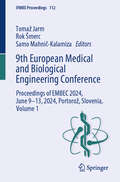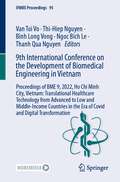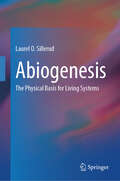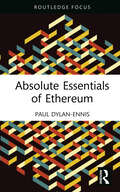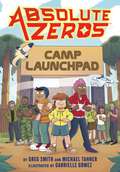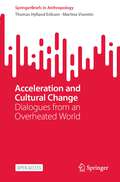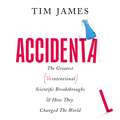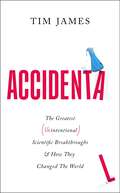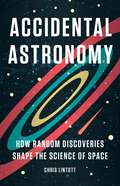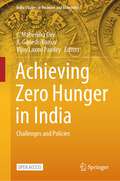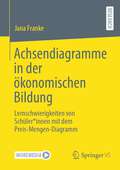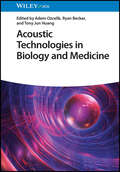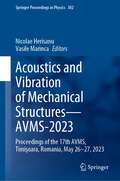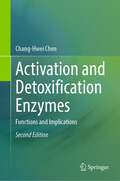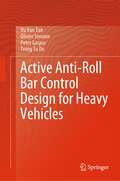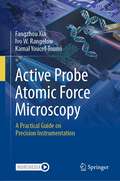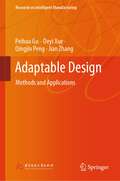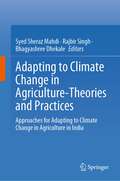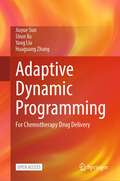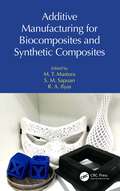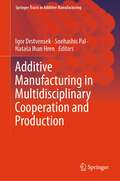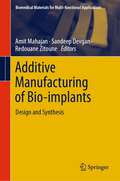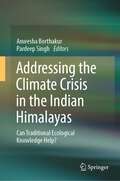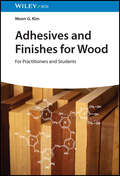- Table View
- List View
9th European Medical and Biological Engineering Conference: Proceedings of EMBEC 2024, June 9-13, 2024, Portorož, Slovenia, Volume 1 (IFMBE Proceedings #112)
by Samo Mahnič-Kalamiza Tomaž Jarm Rok ŠmercThis book informs on new trends, challenges, and solutions, in the multidisciplinary field of biomedical engineering. It covers traditional topics in biomechanics and biomedical signal processing, as well as recent trends relating to the applications of artificial intelligence and machine learning methods in medicine and biology, and to bioengineering education. Gathering the second volume of the proceedings of the 9th European Medical and Biological Engineering Conference (EMBEC 2024), held on June 9-13, 2024, in Portorož, Slovenia, this book bridges fundamental and clinically-oriented research, emphasizing the role of translational research in biomedical engineering. It aims at inspiring and fostering communication and collaboration between engineers, physicists, biologists, physicians and other professionals dealing with cutting-edge themes in and advanced technologies serving the broad field of biology and healthcare.
9th International Conference on the Development of Biomedical Engineering in Vietnam: Proceedings of BME 9, 2022, Ho Chi Minh City, Vietnam: Translational Healthcare Technology from Advanced to Low and Middle-Income Countries in the Era of Covid and Digital Transformation (IFMBE Proceedings #95)
by Van Toi Vo Thi-Hiep Nguyen Binh Long Vong Ngoc Bich Le Thanh Qua NguyenThis book presents cutting-edge research and developments in the field of biomedical engineering, with a special emphasis on results achieved in Vietnam and neighboring low- and middle-income countries. Covering both fundamental and applied research, and focusing on the theme of “Translational Healthcare Technology from Advanced to Low and Middle Income Countries in the Era of Covid and Digital Transformation”, it reports on the design, fabrication, and application of low-cost and portable medical devices, biosensors, and microfluidic devices, on improved methods for biological data acquisition and analysis, on nanoparticles for biological applications, and on new achievements in biomechanics, tissue engineering, and regeneration. It describes the developments of molecular and cellular biology techniques, neuroengineering techniques, and statistical and computational methods, including artificial intelligence, for biomedical applications. It also discusses strategies to address some relevant issues in biomedical education and entrepreneurship. Gathering the proceedings of the 9th International Conference on The Development of Biomedical Engineering in Vietnam, BME 9, held on December 27-29, 2022, in Ho Chi Minh, Vietnam, the book offers important answers to current challenges in the field and a source of inspiration for scientists, engineers, and researchers with various backgrounds working in different research institutes, companies, and countries.
Abiogenesis: The Physical Basis for Living Systems
by Laurel O. SillerudThis textbook serves to teach readers about the origins of life, the probabilistic process of self-assembly underpinning all living systems, from a biophysics perspective. The author cohesively summarizes the various organizing principles that led to the development of an ordered physical basis on which the evolution of life operates. This book answers critical questions, such as why life depends on the properties of inanimate objects and how the laws of physics, chemistry, and biology convolved to spontaneously produce the periodic table and, of course, life itself. Readers are provided with an introduction to probability distributions as well as detailed descriptions of important concepts in thermodynamics, statistical mechanics, and quantum mechanics. As the book progresses, an understanding for the inevitability of life is developed through topics such as stellar nucleosynthesis and prebiotic evolution. Each chapter also includes problems for readers to gain a better understanding of the material. This textbook is accessible to students and researchers of all levels and serves as a comprehensive guide on the physics behind abiogenesis.
Absolute Essentials of Ethereum (Absolute Essentials of Business and Economics)
by Paul Dylan-EnnisAbsolute Essentials of Ethereum is a concise textbook which guides the reader through the fascinating world of the emerging Ethereum ecosystem, from the basics of how its blockchain works to cutting-edge applications.Written by an experienced educator, each chapter is designed to progress potential students from class to class. Technical concepts are clearly explained for those new to the topic and readers are supported with definitions and summaries in each chapter. Real-life case studies situate the overviews in a contemporary context. Topics covered include the Ethereum Execution and Consensus layers, Ethereum governance and community, Decentralised Autonomous Organisations (DAOs), Decentralised Finance (DeFi), Non-Fungible Tokens (NFTs) and Layer 2.This book is the ideal text to support undergraduate and postgraduate courses on blockchain technologies, cryptocurrencies, Web3 and fintech, as well as for those who want to know how Ethereum really works.
Absolute Zeros: Camp Launchpad (Absolute Zeros #1)
by Einhorn's Epic Productions Greg Smith Michael TannerReach for the stars in this exciting graphic novel about three ambitious, space-loving kids who must put their differences aside to save their summer camp before it closes...for good. Welcome to Camp Launchpad! Summer is in full swing, which means a new class of kids has arrived to attend the best space camp in Florida...or at least, it used to be. With growing competition from the trendy rival camp next door, Camp Launchpad needs all the help it can get to keep its doors open. Campers Val, Mark, and Pete are here for very different reasons: following in the footsteps of an astronaut mom, living up to expectations as a vice president&’s son, or getting a once-in-a-lifetime scholarship. But they all have one huge thing in common: Their future in the stars launches from here...if there&’s still a camp to launch from. When the hotshot owner of the rival space camp makes a ten-million-dollar bet that could turn Camp Launchpad around, this unlikely trio must band together to pull off a miracle. If they don&’t, this could be Camp Launchpad&’s last summer ever!
Acceleration and Cultural Change: Dialogues from an Overheated World (SpringerBriefs in Anthropology)
by Thomas Hylland Eriksen Martina VisentinThis open access book includes socio-anthropological and anthropo-sociological conversations between one of the world’s leading anthropologists, Thomas Hyland Eriksen, and a young scholar, using his groundbreaking "overheating" approach.This book includes socio-anthropological and anthropo-sociological conversations between one of the world’s leading anthropologists, Thomas Hyland Eriksen, and a young scholar, using his groundbreaking "overheating" approach. From the pandemic to the spread of nationalism, from the Anthropocene to the Homogenocene, the authors discuss the most urgent issues of current society: e.g., the loss of biological and cultural diversity owing to the forces of globalisation; and the emergence of new forms of diversity through globalisation and migration; the intersectional dimension of climate change; the incredible rising of anger demonstrations around the world and resentful, overheated identities often linked to right-wing nationalism; the way digital devices have changed the meaning of temporality in people's life-worlds; the regulatory and competitive pressures on universities which are a result of many factors in the intersection of globalisation, massification and marketisation; youth's weakened belief in progress connected to changes in the contemporary world, such as growing inequality, political alienation and environmental destruction; recent pathbreaking research and original theory in sociology and anthropology related to the changes in an overheated world; and what post-Coronavirus social life might become. Highly topical, engaging and written in a conversational style, this book is a must-read for social scientists and discerning lay persons who want a fresh perspective on understanding the critical issues of our time. This is an open access book.
Accidental: The Greatest (Unintentional) Science Breakthroughs and How They Changed The World
by Tim James'Who said science was dry? Certainly not Tim James' New York Post 'James writes with infectious enthusiasm and optimism' Kirkus Reviews 'A science teacher by profession, Mr. James knows how to get his audience's attention' Wall Street Journal 'Humorous, yet deep' Professor Charles AntoineA rip-roaring adventure through science gone wrong, and accidentally changing humanity (mostly) for the better.We may imagine that science is a process of breakthroughs and light bulb moments. But in reality, science goes wrong 99% of the time.Almost every idea a scientist comes up with is quickly disproved by a failed experiment or rival research. Science moves at a rate of inches per decade and we often like it that way. But occasionally, just occasionally, a complete fluke happens and changes everything as we know it. From an untimely sneeze in a petri dish leading to the groundbreaking creation of antibiotics, to the incredible discovery of microwaves via melted chocolate, Accidental is a rip-roaring adventure through science gone wrong, and accidentally changing humanity for the better.
Accidental: The Greatest (Unintentional) Science Breakthroughs and How They Changed The World
by Tim James'Who said science was dry? Certainly not Tim James' New York Post 'James writes with infectious enthusiasm and optimism' Kirkus Reviews 'A science teacher by profession, Mr. James knows how to get his audience's attention' Wall Street Journal 'Humorous, yet deep' Professor Charles AntoineA rip-roaring adventure through science gone wrong, and accidentally changing humanity (mostly) for the better.We may imagine that science is a process of breakthroughs and light bulb moments. But in reality, science goes wrong 99% of the time.Almost every idea a scientist comes up with is quickly disproved by a failed experiment or rival research. Science moves at a rate of inches per decade and we often like it that way. But occasionally, just occasionally, a complete fluke happens and changes everything as we know it. From an untimely sneeze in a petri dish leading to the groundbreaking creation of antibiotics, to the incredible discovery of microwaves via melted chocolate, Accidental is a rip-roaring adventure through science gone wrong, and accidentally changing humanity for the better.
Accidental: The Greatest (Unintentional) Science Breakthroughs and How They Changed The World
by Tim James'Who said science was dry? Certainly not Tim James' New York Post 'James writes with infectious enthusiasm and optimism' Kirkus Reviews 'A science teacher by profession, Mr. James knows how to get his audience's attention' Wall Street Journal 'Humorous, yet deep' Professor Charles AntoineA rip-roaring adventure through science gone wrong, and accidentally changing humanity (mostly) for the better.We may imagine that science is a process of breakthroughs and light bulb moments. But in reality, science goes wrong 99% of the time.Almost every idea a scientist comes up with is quickly disproved by a failed experiment or rival research. Science moves at a rate of inches per decade and we often like it that way. But occasionally, just occasionally, a complete fluke happens and changes everything as we know it. From an untimely sneeze in a petri dish leading to the groundbreaking creation of antibiotics, to the incredible discovery of microwaves via melted chocolate, Accidental is a rip-roaring adventure through science gone wrong, and accidentally changing humanity for the better.
Accidental Astronomy: How Random Discoveries Shape the Science of Space
by Chris LintottA "riveting real-life Hitchhiker's Guide to the Galaxy" (The Telegraph) and "whirlwind tour of wondrous celestial phenomena" (The Idler) shows why so much of astronomy comes down to looking up and lucking out If you learn about the scientific method, you learn that first we hypothesize about something we&’ve experienced, and then we look for more of it. This works well enough—but what if you are interested in studying a heretofore unknown comet or supernova? That is the essential problem of the astronomer: the most important discoveries happen without notice! Indeed, as Chris Lintott argues in Accidental Astronomy, luck defines astronomy. Lintott explores the ways in which happenstance shapes how we investigate the sky. To catch a glimpse of a comet, asteroid, or even a sign of alien life, we must be in the right place at the right time. And if we can&’t be there, we must have a team of professionals and amateurs, across the globe, ready to spring into action at a moment&’s—or a night&’s—notice. For any astronomer, regardless of their experience or resources, the first step to discovery is the same: to stare at the sky and wait. A celebration of astronomy, stargazing, and cosmic discovery, Accidental Astronomy offers an irresistible window into how luck defines our knowledge of the skies.
Achieving Zero Hunger in India: Challenges and Policies (India Studies in Business and Economics)
by S. Mahendra Dev A. Ganesh-Kumar Vijay Laxmi PandeyThis open access volume discloses rich set of findings and policy recommendations for India towards achieving the SDG 2.1 target of zero hunger by 2030. Through its fourteen chapters, it takes an integrated approach by examining diverse aspects of food and nutrition security through multidisciplinary lens of Agricultural Economics, Nutrition, Crop Sciences, Anthropology and Law, while being rooted in economics. The chapters reflect this diversity in disciplines in terms of the questions posed, the data sets used, and the methodologies followed. Starting from the evolution of policy response for hunger and nutrition security, the book covers aspects such gender budgeting, dietary diversity, women’s empowerment, calorie intake norms, socio-legal aspects of right to health, subjective wellbeing, bio-fortification, crop insurance and food security linkages, interdependence of public distribution system (for food security) and employment guarantee schemes especially during COVID-19 pandemic, effects of dairy dietary supplements, and so on. With its rich discussions, the book is compelling for students, researchers, policy makers, development professionals and practitioners working in areas of food and nutrition security, SDGs, in particular SDG1, SDG2 and SDG5, and sustainable food systems.
Achsendiagramme in der ökonomischen Bildung: Lernschwierigkeiten von Schüler*innen mit dem Preis-Mengen-Diagramm
by Jana FrankeÖkonomische Modelle werden durch bewusste Reduktion der Komplexität des Betrachteten mit dem Ziel des Erkenntnisgewinns entwickelt. Mithilfe von mathematischen Modellierungen können ökonomische Modelle exakter gefasst werden. Dieses Resultat ist ein wichtiges Werkzeug bei der Ermittlung und Darstellung von Systemzusammenhängen. Durch die Visualisierung der mathematischen Modellierungen mit dem Achsendiagramm werden abstrakte Zusammenhänge erkennbar und diskutierbar. Deshalb finden ökonomische Achsendiagramme in der Schule unter anderem als Hilfsmittel zur systematischen Betrachtung einzelner Einflussfaktoren eines komplexen Interaktionssystems, wie beispielsweise der Preisbildung auf Märkten, Einsatz. Die Visualisierung des ökonomischen Modells der Preisbildung auf Märkten mithilfe des Preis-Mengen-Diagramms kann dabei die ökonomischen Verständnisprozesse fördern, sie aber auch behindern. Inwieweit das Preis-Mengen-Diagramm somit Hilfsmittel und Hürde im Wirtschaftsunterricht darstellt, wird in diesem Buch untersucht. Dafür werden Lernschwierigkeiten von Schüler*innen beim Umgang mit und dem Wissen über die mathematische Modellierung des ökonomischen Modells der Preisbildung im vollkommenen Markt und dessen Visualisierung durch das Preis-Mengen-Diagramm identifiziert. Darauf aufbauend werden Implikationen für den Wirtschaftsunterricht abgeleitet.
Acoustic Technologies in Biology and Medicine
by Adem Ozcelik Ryan Becker Tony Jun HuangAcoustic Technologies in Biology and Medicine Complete, balanced resource encompassing all required technical, theoretical, and applied multidisciplinary knowledge related to acoustics Taking a multidisciplinary approach involving fluid mechanics, physics, chemistry, electronics, and the life sciences to provide a unified and competent overview of the field, Acoustic Technologies in Biology and Medicine covers the fundamental principles of acoustic wave generation and propagation, different acoustic systems and technologies with the interplay of physical forces, theoretical foundations, and the state-of-the-art biomedical applications of acoustics. State-of-the-art applications of acoustics in biology and medicine are presented, including single cell and organism manipulation, acoustic biosensing, cancer cell isolation (liquid biopsy), cell/tissue stimulation and ablation, micro-robot actuation, acoustic imaging, and drug delivery. Contributed to and edited by highly qualified professionals with significant experience in the field, Acoustic Technologies in Biology and Medicine covers sample topics such as: Materials for acoustic wave generation and modulation, ultrasound imaging, and photoacoustic imaging and sensing for biomedical applications Therapeutic ultrasound, application of ultrasound responsive reagents for drug delivery systems, and acoustic levitation and acoustic holograms Application of ultrasonic waves in bioparticle manipulation and separation, acoustic biosensors, and acoustic micro and nanorobots in medicine Different technologies of acoustic systems, including bulk and surface acoustic wave-based platforms, acoustic imaging, acoustic sensors, and acoustic levitators A cornerstone reference bridging the gap between rapidly advancing acoustic technologies with state-of-the-art applications in biology and medicine, Acoustic Technologies in Biology and Medicine is an essential resource on the subject for biophysicists, materials scientists, biotechnologists, bioengineers, sensor developers, electronics engineers, and all professionals in the greater biotechnological industry.
Acoustics and Vibration of Mechanical Structures—AVMS-2023: Proceedings of the 17th AVMS, Timişoara, Romania, May 26–27, 2023 (Springer Proceedings in Physics #302)
by Nicolae Herisanu Vasile MarincaThis book presents peer-reviewed and selected papers from the 17th Conference on Acoustics and Vibration of Mechanical Structures (AVMS) held in Timisoara, Romania, on 26–27 May 2023. Internationally recognized experts share their knowledge and key findings in a broad range of topics related to acoustics and vibration of mechanical structures such as analytical, numerical and experimental techniques for noise and vibration problems, environmental and occupational noise and vibration, modelling, prediction and simulations of noise and vibration, noise and vibration control, noise and vibration attenuators. The book addresses application studies and fundamental studies as well, and it is meant for academics researchers and professionals, as well as Ph.D. students concerned with various fields of acoustics and vibration of mechanical structures.
Activation and Detoxification Enzymes: Functions and Implications
by Chang-Hwei ChenThis book discusses the many advances in the understanding of the functions and implications of activation and detoxification enzymes. This organized, concise overview will meet the needs of those who are initially exposed to this important subject, particularly for students and researchers in the areas of biomedical sciences, biochemistry, nutrition, pharmacology, and chemistry. The book will also be valuable to advanced researchers. The book discusses subjects associated with foreign-compound-metabolizing enzymes with emphasis on biochemical aspects, including lipophilic foreign compounds, activation and detoxification enzymes, metabolic enzyme catalytic properties, reactive metabolic intermediates, biomedical and biochemical effects, genetic polymorphisms, enzyme inducibility, enzyme modulation for health benefits, dietary-related enzyme modulators, and structural characteristics of enzyme inducers. This new edition is updated throughout andfeatures completely new chapters on Oxidative and Electrophilic Stresses, Metabolite- Mediated Disease Conditions, and Defense Mechanism: Nrf2-ARE Pathway.
Active Anti-Roll Bar Control Design for Heavy Vehicles
by Vu Van Tan Olivier Sename Peter Gaspar Trong Tu DoThis book provides a comprehensive overview of active anti-roll bar systems on heavy vehicles as one of the most effective solutions for improving the roll stability of these vehicles. Due to the characteristics of these vehicles with heavy loads and high center of gravity, the possibility of roll instability occurs frequently and causes serious consequences for human life, vehicles, and traffic infrastructure. The book gives readers an in-depth survey of the roll instability characteristics of heavy vehicles such as single-unit trucks with rigid and flexible frames, and tractor semi-trailers. It then introduces an active anti-roll bar system, the electro-hydraulic actuators which use control methods such as LQR optimal and H∞ robust controller design. This work introduces a new control method, which is a combination of robust control with the linear parameter varying system (H∞/LPV). The validation of the new hybrid method is carried out using the nonlinear truck model from the TruckSim® software to assess the roll stability of heavy vehicles in order to limit the rollover accident. A number of examples are provided to illustrate the research results, which helps the readers have a practical and easy approach that can be applied to other active anti-roll bar systems for most forms of transport vehicles in general. This book caters to academics and practitioners who are interested in active anti-roll bar systems for the typical heavy vehicle available worldwide.
Active Probe Atomic Force Microscopy: A Practical Guide on Precision Instrumentation
by Fangzhou Xia Ivo W. Rangelow Kamal Youcef-ToumiFrom a perspective of precision instrumentation, this book provides a guided tour to readers on exploring the inner workings of atomic force microscopy (AFM). Centered around AFM, a broad range of mechatronic system topics are covered including mechanics, sensors, actuators, transmission design, system identification, signal processing, dynamic system modeling, controller. With a solid theoretical foundation, practical examples are provided for AFM subsystem level design on nano-positioning system, cantilever probe, control system and system integration. This book emphasizes novel development of active cantilever probes with embedded transducers, which enables new AFM capabilities for advanced applications. Full design details of a low-cost educational AFM and a Scale Model Interactive Learning Extended Reality (SMILER) toolkit are provided, which helps instructors to make use of this book for curriculum development. This book aims to empower AFM users with deeper understanding of the instrument to extend AFM functionalities for advanced state-of-the-art research studies. Going beyond AFM, materials presented in this book are widely applicable to precision mechatronic system design covered in many upper-level graduate courses in mechanical and electrical engineering to cultivate next generation instrumentalists.
Adaptable Design: Methods and Applications (Research on Intelligent Manufacturing)
by Peihua Gu Deyi Xue Qingjin Peng Jian ZhangThis book provides a comprehensive discussion of Adaptable Design (AD). It covers the conception, method, and application of AD to the real-world product design. AD's benefits are substantial as it upgrades, reuses, remanufactures and recycles products throughout the product lifecycle. It rapidly adapts the existing design in development of new designs. Key elements of AD include rationalized function structures, adaptable product architectures, adaptable interfaces, and adaptability evaluations. The main feature of AD is adaptability in design methods and product applications with general and specific adaptability. AD has also modeling and evaluating adaptabilities.
Adapting to Climate Change in Agriculture-Theories and Practices: Approaches for Adapting to Climate Change in Agriculture in India
by Syed Sheraz Mahdi Rajbir Singh Bhagyashree DhekaleThis book brings together a series of chapters that provides updated information on adaptation practices against climate change in agriculture and livestock. Information on some new aspects like conservation of carnivorous plants, climate-smart millets production, advances in genomic interventions for climate resilient crops, perceptions on disease and pests under changing climate, role of neglected crops in climate resilient agriculture, nanotechnology in sustainable agriculture, use of crop wild relatives for developing climate resilient crops have been discussed. It also presents detailed information carbon sequestration practices and green consumption behaviour for sustainable development. The last chapter of book mentions about an innovative agronomic technique under rainfed conditions for sustainable yield advantage in soybean crop.
Adaptive Dynamic Programming: For Chemotherapy Drug Delivery
by Jiayue Sun Shun Xu Yang Liu Huaguang ZhangThis open access book focuses on the practical application of Adaptive Dynamic Programming (ADP) in chemotherapy drug delivery, taking into account clinical variables and real-time data. ADP's ability to adapt to changing conditions and make optimal decisions in complex and uncertain situations makes it a valuable tool in addressing pressing challenges in healthcare and other fields. As optimization technology evolves, we can expect to see even more sophisticated and powerful solutions emerge.
Additive Manufacturing for Biocomposites and Synthetic Composites
by M. T. Mastura S. M. Sapuan R. A. IlyasAdditive Manufacturing for Biocomposites and Synthetic Composites focuses on processes, engineering, and product design applications of bio-composites and synthetic composites in additive manufacturing (AM). It discusses the preparation and material characterization and selection, as well as future opportunities and challenges. Reviews the latest research on the development of composites for AM and the preparation of composite feedstocks Offers an analytical and statistical approach for the selection of composites for AM, including characterization of material properties Emphasizes the use of environmentally friendly composites Analyzes the lifecycle including costs Considers potential new fibers, their selection, and future applications This book provides a comprehensive overview of the application of advanced composite materials in AM and is aimed at researchers, engineers, and advanced students in materials and manufacturing engineering and related disciplines.
Additive Manufacturing in Multidisciplinary Cooperation and Production (Springer Tracts in Additive Manufacturing)
by Igor Drstvensek Snehashis Pal Nataša Ihan HrenThis book publishes the latest findings and ideas in the field of additive manufacturing presented by authors from prominent institutions around the world at the iCAT 2023 conference. The authors address various technological and medical aspects, ranging from materials science to the specific behaviour of the technology under different working conditions. The book is divided into four sections, three of which are dedicated to the purely technological aspects of additive manufacturing, covering metal processes, polymer processes and simulation. The fourth part of the book is dedicated to the medical applications of additive manufacturing, covering areas ranging from orthopaedic surgeries to materials used in medical AM.Overall, the book provides insight into the current state of the science and applications of additive manufacturing.
Additive Manufacturing of Bio-implants: Design and Synthesis (Biomedical Materials for Multi-functional Applications)
by Amit Mahajan Sandeep Devgan Redouane ZitouneThis contributed volume presents the latest research on additive manufacturing (AM) or 3D printing, one of the key techniques of novel medical devices, which can process complicated or customized structures to match the properties of human tissues. AM allows for the fabrication of devices with optimal architectures, complicated morphologies, surface integrity, and regulated porosity and chemical composition. Various AM methods can now consistently fabricate dense products for a variety of materials, comprising steels, titanium alloys, Co-Cr alloys, metal-based composites, and nanocomposites. This book elucidates the chronology of various techniques that are categorized under additive manufacturing. Moreover, the futuristic techniques or advancements in this area are also described. The available literature focuses on the microstructure and various properties of 3D-printed alloys. However, the research on the wear characteristics, corrosion resistance, and biocompatibility of 3D-printed technology for biomedical applications is limited. This book comprises the helicopter view of different surface analysis trends of additive manufactured alloys. The book can be a valuable reference for beginners, researchers, and professionals interested in bioimplant manufacturing and allied fields.
Addressing the Climate Crisis in the Indian Himalayas: Can Traditional Ecological Knowledge Help?
by Anwesha Borthakur Pardeep SinghThis book focuses on the traditional ecological knowledge in addressing the current climate crisis in the Indian Himalayas. Local or indigenous people in the Himalayas, through their low-carbon producing lifestyles, contribute very little to the climate crisis. However, at the same time, they bear the brunt of this crisis way more than many others. It is important to learn about their traditional ways of life and the knowledge that they hold regarding ecology and environment. Traditional ecological knowledge and associated belief systems are given increasing attention across the globe in recent times toward addressing some of the grave environmental concerns. Climate change is one such concern. The rising consideration of concepts such as ethnoecology and ethnobotany signifies the scientific, socio-cultural and economic potential of the traditional ecological knowledge systems. It is indisputable that these knowledge systems have the ability to provide important insights towards tackling many present-day environmental distresses including several climate change challenges. In this book, the authors concentrate on such traditional ecological knowledge systems in the Indian Himalayan region and try to figure out their significance in relation to the modern science. Overall, the authors attempt to write a book where the relevance of traditional ecological knowledge systems could be addressed and communicated to a larger audience—both academic scientific and non-academic.
Adhesives and Finishes for Wood: For Practitioners and Students
by Moon G. KimAdhesives and Finishes for Wood Understand the science of joining wood with this comprehensive guide Long seen as an old-fashioned material with narrowing modern applications, wood has seen increased popularity as a material in building and manufacturing in recent years. This has been driven by the need for sustainable resources and environmentally friendly materials. As a result of increased emphasis on wood, however, there is a corresponding need to understand the wood adhesives, the crucial materials in wood-based manufacture and craftsmanship. Adhesives and Finishes for Wood meets this need with a comprehensive but accessible introduction to the chemistry and applications of wood adhesives. Its easy-to-follow presentation nonetheless presents wood adhesives and finishes in significant detail. Ideal for readers without considerable preexisting knowledge in chemistry, this book includes everything the reader needs to understand and apply wood adhesives in their work or industry. Adhesives and Finishes for Wood readers will also find: Coverage ranging from the fundamentals of wood adhesive polymer chemistry to the properties of specific wood structures and resins A presentation suitable for both academic students and wood manufacture professionals An author with decades of experience in both academia and industry Adhesives and Finishes for Wood is a useful reference for advanced students and professionals in industries or manufacturing disciplines that incorporate wood, as well as for chemists, materials scientists, vocational school instructors, and more.
